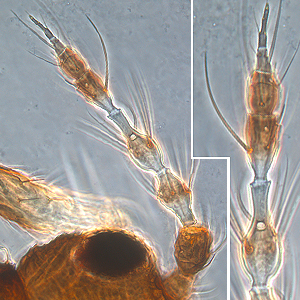Figures
Fig. 1: Antenna (inset: IV. - VIII. antennal segment)
Fig. 2: Head dorsal with ocellar triangle
Fig. 3: Pronotum
Fig. 4: Meso- and metanotum
Fig. 5: Metathoracic furca
Fig. 6: Forewing
Fig. 7: Tergites VI and VII
Fig. 8: Tergites VIII-X
ITS-RFLP gel patterns (1&8 ladder, 2 PCR-product, 3 RSAI, 4 HaeIII, 5 MspI, 6
HinfI, 7 AluI)
Fig. 9: Primer pair O1/18J
Fig. 10: Primer pair P1/28Z
Fig. 11: Primer pair TODA1/TODA2
Taxonomic Information
Species:
Selenothrips rubrocinctus (Giard, 1901)
Synonyms:
Selenothrips indicus Bagnall, 1929
Brachyurothrips indicus Bagnall, 1926
Heliothrips (Selenothrips) mendax Schmutz, 1913
Heliothrips (Selenothrips) decolor Karny, 1911
Physopus rubrocinctus Giard, 1901
Common name:
Cacao or Red-banded thrips
Present taxonomic position:
Family: Thripidae Stephens, 1829
Subfamily: Panchaetothripinae Bagnall, 1912
Genus: Selenothrips Karny, 1911
Species Recognition
General information about the genus Selenothrips:There is only one species recognized in this genus and is unique within the Panchaetothripinae in having long setae on the antennal segments, two rows of long dark stout setae on the forewings, the antennal segments III and IV are constricted apically and each of these segments has a long forked sense cone. Common characters within the Panchaetothripinae include heavy reticulate sculpture on a dark brown body and legs, forewing first vein fusing with the costa, and the metathoracic furca without a spinula.
Typical character states of Selenothrips rubrocinctus:
Body color
Mainly brown
Antennae
Number of antennal segments: 8
Segment IV - forked sensorium: extending to a point at least 30% distal to base of segment V
Segments III & IV sensoria: emergent and forked
Terminal antennal segments: very long, needle like
Head:
Head shape between compound eyes: distinctly prolonged
Sculptured reticles on head and pronotum: with no internal markings
Surface of head, pronotum and fore legs: with strong reticulate sculpture, but sometimes irregular
Head posteriorly: constricted
Prothorax
Number of pairs of elongate pronotal setae: 0-3
Number of pairs of elongate posteroangular pronotal setae: 0
Pronotum shape: rectangular
Sculptur of pronotum: with transverse striate sculpture
Mesothorax
Mesothoracic endofurca: without median spinula
Metathorax
Metanotum: with or without campaniform sensilla
Metanotum major sclerite: with two major sclerites, metascutum and metascutellum
Metanotum median area: with no equiangular reticulation
Metanotum sculpture: with dominant sculptured triangle medially
Metathoracic endofurca: elongate and Y-shaped
Wings
Wings: present and more than half as long as abdomen
First vein of forewing: close to or fused to costal vein
Forewing anterior margin: with setae and cilia but cilia longer than setae
Forewing color: uniformly dark brown
Forewing costal setae at middle of wing: longer than median width of wing
Forewing first vein setal row: complete, with setae closely and uniformly spaced
Forewing posterior margin cilia: undulated near apex
Forewing second vein setal row: complete, with setae closely and uniformly spaced
Forewing surface: not reticulate
Forewings: with veins, setae and microtrichia
Legs
Mid and hind tarsi: with one segment
Abdomen:
Abdominal segment X: never tubular, longitudinally incomplete ventrally in both sexes
Abdominal tergites: without curved wing-retaining setae
Abdominal tergites IV & V median setal pair: longer than distance between their bases
Setae on abdominal tergite X: slender
Tergite VIII posteromarginal comb of microtrichia: present, complete medially
Tergites III to VI sculpture on lateral thirds: comprising mainly oblique reticulations
Biology
Life history:
Selenothrips rubrocinctus is a slow moving insect requiring prodding to take a few steps across the leaf. The larvae have three red-colored bands developed from internal pigmentation. Thus is the reason for the common name ‘red-banded cacao thrips’. Incubation time from egg to adult can take one week to one month dependent upon seasonal temperatures.
Host plants:
Polyphagous, mainly on Theobroma
cacao
Vector capacity:
None identified
Current known distribution:
Africa, Asia, Australia, New Zealand,
Central and South America, North America
Additional notes:
This species is particularly common on weak or damaged host plants, taking advantage of nutritional abnormalities by feeding on the leaves.
Bibliography
Ananthakrishnan, TN & Muraleed, N (1972):
Free amino-acids in relation to
host plant preferences in polyphagous Heliothripines Rhipiphorothrips
cruentatus Hood and Retithrips syriacus (Mayet). - Current Science
41 (23): 846-847.
Dhaliwal, JS (1975): Polistes hebraeus (Fabricius)
preying upon Rhipiphorothrips cruentatus Hood (Thripidae-Thysanoptera).
- Current Science 44 (10): 368-368.
Fennah RG (1965): The influence of environmental stress on
the cacao tree in predetermining the feeding sites of cacao thrips, Selenothrips
rubrocinctus (Giard), on leaves and pods. Bulletin of Entomological
Research 56: 333-349.
Lewis, T (1973): Thrips their biology, ecology and
economic importance. Academic Press Inc., London Ltd. 349 pp.
Moritz G, Morris DC, Mound LA (2001): ThripsID -
Pest thrips of the world. ACIAR
and CSIRO Publishing Collingwood, Victoria, Australia, CDROM ISBN
1 86320 296 X.
Moritz G, Mound LA, Morris DC, Goldarazena A (2004): Pest
thrips of the world - an identification and information system using molecular
and microscopial methods. CBIT, University of Queensland,CDROM ISBN 1-86499-781-8..
Mound, LA & Marullo, R (1996): The
thrips of Central and South America: An Introduction (Insecta: Thysanoptera).
Associated Publishers, Gainesville.
Suresh, G & Ananthakrishnan, TN
(1987): Biochemical correlates in Rhipiphorothrips
cruentatus Terminalia catappa
interactions with special reference to leaf infestation patterns. - Proceedings
of the Indian Academy of Sciences-Animal Sciences 96 (2): 117-127.
Wilson, TH (1975): A monograph of the subfamily Panchaetothripinae
(Thysanoptera: Thripidae). Memoirs of the American Entomological Institute 23:
1-354.
Links:
Mound, LA (2005): Thysanoptera (Thrips) of the World
- A Checklist. http://www.ento.csiro.au/thysanoptera/worldthrips.html












